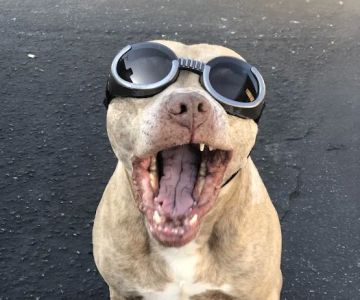Best Dog Collars for All Breeds: A Complete Guide for Pet Owners
When I first brought my dog, Max, into my home, one of the first things I had to think about was getting him a proper collar. I quickly realized that choosing the right collar wasn't just about style or appearance—it was essential for his safety, comfort, and training. With so many different types of collars available, from traditional flat collars to more specialized options like harnesses and training collars, it can be overwhelming to know which one is best for your dog. This article will guide you through the best dog collars for all breeds, helping you make an informed decision on what collar suits your dog's needs and your lifestyle.

1225 Warren Ave, Downers Grove, IL 60515, USA
See Details1. Understanding the Importance of Choosing the Right Collar
Choosing the right dog collar is crucial because it affects your dog's comfort, safety, and behavior. Not all collars are suitable for every dog breed or situation, and selecting the wrong one can lead to discomfort, skin irritation, or ineffective training. When I first got Max, I didn’t know how important it was to match the collar type with his specific needs. Some collars are better for training, while others are designed for comfort or identification. Before buying a collar, it’s important to understand your dog’s size, breed, and behavior to find the perfect fit.
2. Types of Dog Collars: Which One Is Right for Your Dog?
There are several types of dog collars, and each one serves a different purpose. When I began looking for the best collar for Max, I quickly realized that one size and type doesn’t fit all. Here’s an overview of the most common types of dog collars:
2.1. Flat Collars
The most common and traditional type of dog collar is the flat collar. This collar is typically made from nylon or leather and is used primarily for everyday wear. It's ideal for holding your dog’s ID tags and can be used for walking or training. Flat collars come in various sizes and designs, making them a versatile choice for most dogs.
For Max, a flat collar worked perfectly for everyday use. It was comfortable for him, and I could easily attach his leash and ID tags to it. However, I soon realized that some breeds with thicker necks, like Bulldogs or Huskies, might need a wider flat collar for added comfort and support.
2.2. Harnesses
Harnesses are a great alternative to flat collars, especially for dogs that pull on the leash or have respiratory issues. Harnesses distribute the pressure evenly across the dog’s chest, preventing strain on their neck and throat. I found that Max, who tends to pull on walks, responded better to a harness than a flat collar. Harnesses are also ideal for smaller dogs or those with neck problems, as they prevent any choking or discomfort from excessive pulling.
When choosing a harness, it's important to get one that fits snugly but not too tight. A well-fitting harness will help you maintain control of your dog during walks and prevent unwanted slipping or tugging.
2.3. Training Collars
If your dog is in need of behavior correction, a training collar might be necessary. These collars come in a few different types, including prong collars, choke chains, and electronic collars. Although I initially hesitated to use a training collar, I found them useful when training Max, especially during leash training. However, I made sure to use the collar with caution, and only under the guidance of a professional trainer, to ensure it was effective and not harmful.
Training collars should never be used as a punishment tool. When used correctly, they can be an effective way to correct behavior and improve leash walking. I highly recommend consulting a trainer to learn how to use training collars appropriately.
2.4. Martingale Collars
Martingale collars are a combination of flat collars and training collars, offering more control without causing harm to your dog. These collars are often used for dogs that have narrower heads or are prone to slipping out of their collars, like Greyhounds or Whippets. The Martingale collar tightens slightly when pulled, providing more control, but it doesn’t constrict like a choke chain or prong collar.
For Max, a Martingale collar provided the right balance of comfort and security, especially when we were out walking in busy areas where he was more likely to pull. I liked how the collar kept him from slipping out without causing discomfort or injury. Martingale collars are a great choice for dogs that are escape artists or have sensitive necks.
3. Sizing and Adjusting Your Dog's Collar
One of the most important aspects of choosing a dog collar is getting the right size. A collar that is too tight can cause discomfort or injury, while one that is too loose might slip off or fail to keep your dog under control. When selecting a collar for Max, I made sure to measure his neck carefully and adjust the collar to fit snugly, but not too tightly. I could fit two fingers between the collar and his neck, which is a good rule of thumb for comfort.
Most collars come with adjustable straps, making it easy to customize the fit. When adjusting the collar, always ensure that it sits comfortably around your dog’s neck, not too tight to restrict movement or too loose to allow for slipping. It’s important to check the fit regularly, especially as your dog grows or gains weight.
4. Materials and Durability: Choosing the Best Collar for Your Dog
Collars come in a variety of materials, each offering different levels of durability, comfort, and weather resistance. Here’s a breakdown of the most common materials:
4.1. Nylon
Nylon is one of the most common materials used for dog collars. It’s lightweight, durable, and comes in a variety of colors and patterns. Nylon collars are easy to clean and can withstand everyday wear and tear. I chose a nylon collar for Max because it was comfortable, easy to adjust, and could handle the elements during our outdoor activities.
4.2. Leather
Leather collars are known for their durability and timeless look. They’re often thicker than nylon collars and can withstand more wear, making them a great choice for dogs that love outdoor adventures. Leather also tends to be gentler on your dog’s fur and is less likely to cause irritation. However, leather collars require regular maintenance to keep them from becoming stiff or cracked, especially if your dog spends time in the rain or mud.
4.3. Biothane
Biothane collars are a newer option that offers the durability of leather with the easy-to-clean nature of nylon. These collars are waterproof, odor-resistant, and perfect for dogs that love water or tend to get messy. I found a Biothane collar to be ideal for Max when we went on hikes or to the beach. They’re also easy to clean, which made maintenance a breeze.
5. Reflective Collars for Added Safety
If you walk your dog in the early morning or late evening, it’s important to prioritize their visibility for safety. Reflective collars are an excellent choice for enhancing your dog’s visibility during low-light conditions. Max’s reflective collar allowed me to see him clearly during our nighttime walks, and it helped ensure that drivers and pedestrians could spot him from a distance.
Reflective collars come in various styles and materials, including nylon and leather, and they feature strips or stitching that reflect light. I highly recommend using reflective collars if you frequently walk your dog in dimly lit areas.
6. Maintaining Your Dog’s Collar
Regular maintenance is key to ensuring your dog’s collar lasts and remains comfortable. I made it a habit to check Max’s collar every few weeks to ensure it was still in good condition. I would clean his nylon collar with mild soap and water and occasionally condition his leather collar to keep it soft and durable. Regularly inspect the collar for signs of wear and tear, especially the buckle, and replace it if necessary.
Also, make sure to replace your dog’s collar if it becomes too loose or tight due to weight fluctuations. A well-maintained collar will not only last longer but will also keep your dog comfortable and safe.











